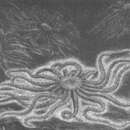Comprehensive Description
provided by Smithsonian Contributions to Zoology
Freyella elegans (Verrill, 1884)
Brisinga elegans Verrill, 1884:382 [non Brisinga elegans Perrier, 1885 (= Novodina homonyma Downey, new name).]
Freyella spinosa Perrier, 1885c:5; 1894:85–89, pl. 7.—Koehler, 1907:6.—Mortensen, 1927:129.—Sibuet, 1975:281.—Gage et al., 1983:285.—Korovchinsky and Galkin, 1984:1213 [key].
Freyella bracteata Sladen, 1889:629–632, pl. 114: figs 1–4.
Freyella elegans.—Verrill, 1894:283; 1895:212.
Freyella spinosa Perrier, 1885c:5; 1894:85–89, pl. 7.—Koehler, 1907:6.—Mortensen, 1927:129.—Sibuet, 1975:281.—Gage et al., 1983:285.—Korovchinsky and Galkin, 1984:1213 [key].
Freyella abyssicola.—A.H. Clark, 1949:375.
Freyella laubieri Cherbonnier and Sibuet, 1972:1353, unnumbered figure.
MERISTICS.—Arms = 9–14, R = 135–191 mm, r = 5–15 mm, R/r = 12–27/1, length of gonadal region = 21–44 mm, length of longest arm spine = 7–9 mm.
DIAGNOSIS.—[80.a,b,c] Madreporite inconspicuous to moderately large; [100.a] madreporite channeled; [110.e,f] abactinal disc plates thin, flat; scale-like; [120.c] abactinal disc plates imbricate; [130.a] abactinal disc plates bearing 2–5 short, sharp, usually divergent spinelets; [170] number of arms 9–14; [205.a,c] gonadal region of arms 21–44 mm long, slightly to highly inflated; flated; [210.f] abactinal arm plates flat, diamond-shaped; [220.b] abactinal arm plates tessellate, closely abutting adjoining plates; [240.a] abactinal arm costae bearing single irregular transverse row of short, sharp spinelets; [250.a] terminal plates tiny; [260.a] terminal plates bifurcate; [270.a] terminal plates armed with 1 or 2 acute spines; [280.a] marginals small; [290.c] marginals tuberculate; [310.a] marginals bearing 1 long stout acicular spine; [320.a] adambulacrals higher than long, with inner distal prolongation; [330.a] adambulacral plates cylindrical; [340.a] furrow margin straight; [350] number of furrow spines 0–2; [360.a] furrow spines short, sharp; [370.b] furrow spines distal; [380] number of subambulacral spines 1; [390.a,b,c] subambulacral spines large, stout, aciculate, capitate, or truncate (usually capitate or truncate in gonadal region, aciculate beyond); [420.a] ambulacral plates rather high; [430.e] ambulacral plates dumbbell-shaped, head large, elongate, spool-shaped; [470.c] tubefeet neither particularly delicate or particularly heavy; [480.a] mouth plates rather small; [490.c] mouth plates slightly longer than broad; [500] number of preoral spines per mouth plate 2 or 3; [510.a,b] preoral spines short, blunt or acicular, divergent; [520.a,b] preoral spines adoral or lateral; [540.a] lateral oral spines short, acicular; [550.c] lateral oral spines at distal angle of mouth plates; [560] number of suboral spines per mouth plate 1–3; [570.a] suboral spines long, stout, acicular; [580.a] suboral spines above center of mouth plate; [620.a,b,e] pedicellariae scattered on both surfaces of disc and arms; [630.a] all pedicellariae small.
COLOR.—Unknown.
TYPES.—Syntypes: USNM 6740, 11 specimens, Albatross Sta 2105, off Virginia, 2551 m; USNM 8076, 5 specimens, Albatross Sta 2229, off Maryland, 2602 m; USNM 9015, 10 specimens, Albatross Sta 2084, off George's Bank, 2359 m; USNM 9016, Albatross Sta 2076, off George's Bank, 1657 m; USNM 9065, 2 specimens, Albatross Sta 2035, off Nantucket Shoals, 2491 m; USNM 18305, 3 arm fragments, Albatross Sta 2077, off Martha's Vineyard, 2295 m; USNM 18455, 14 specimens, Albatross Sta 2105, off Virginia, 2551 m.
MATERIAL EXAMINED.—Syntypes; 1 specimen, USNM 7819, Albatross Sta 2209, S of Block Island, 1829 m; 1 specimen, USNM 7854, Albatross Sta 2211, Cape Hatteras to Nantucket, 1946 m; 1 specimen, USNM 8135, Albatross Sta 2230, off Delaware, 2136 m; 1 specimen, USNM 11257, Albatross Sta 2534, SE of George's Bank, 2257 m; 4 specimens, USNM 11258, Albatross Sta 2564, SW of Martha's Vineyard, 2542 m; 6 specimens, USNM 11259, Albatross Sta 2562, SW of Martha's Vineyard, 2622 m; 8 specimens, USNM 15560, Albatross Sta 2725, off Chesapeake Bay, 2513 m; 1 specimen, USNM 15561, Albatross Sta 2727, off Chesapeake Bay, 2266 m; 1 arm fragment, USNM 18306, Albatross Sta 2192, S of Nantucket, 1939 m; 2 specimens, USNM 38452, Albatross Sta 2229, Cape Hatteras to Nantucket, 2602 m; 32 specimens, USNM 38862, Albatross Sta 2105, between Cape Hatteras and Nantucket, 2551 m; 3 specimens, USNM 38926, Albatross Sta 2229, Cape Hatteras to Nantueket, 2602 m; 4 specimens, USNM E12438, 34°45′N, 75°11′W, 2450 m; 1 arm fragment, USNM E15979, “Knorr” Sta 326, Hudson Canyon; 5 specimens, USNM E15982, “Knorr” Sta 325, Hudson Canyon, 39°13′N, 71°53′W, 1919 m; 2 specimens, USNM E20944, Pillsbury Sta 292, Gulf of Guinea, 0°12′N, 5°11′E, 3587 m; 1 specimen, USNM E20945, Pillsbury Sta 34, Gulf of Guinea, 3°53′N, 2°33′W, 1986 m; 1 specimen, USNM E13828, Chain Sta 249; 2 specimens, USNM 6740, Albatross Sta 2105, off Virginia, 2551 m; 5specimens, USNM 12068, Albatross Sta 2571, SE of George's Bank, 2480 m (the last two lots were originally labelled “Brisinga spinulosa” but this name was never published; Verrill evidently meant it for a replacement name); type of Freyella spinosa Perrier, Paris Museum, about 19°N, 20°W, 2320-4060 m; type of Freyella aspera Verrill, USNM 6301, Albatross Sta 2097, off Martha's Vineyard, 3506 m; type of Freyella bracteata Sladen, Challenger Sta 46, E of New Jersey, 40° 17′N, 66°48′W, 2469 m; type of Freyella laubieri Cherbonnier and Sibuet, Jean Charcot Sta 17, 52°45′N, 41° 12′W, 4340 m.
DISTRIBUTION.—Greenland to Angola (east) and North Carolina (west); 1600-4500 m.
- bibliographic citation
- Downey, Maureen E. 1986. "Revision of the Atlantic Brisingida (Echinodermata:Asteroidea), with description of a new genus and family." Smithsonian Contributions to Zoology. 1-57. https://doi.org/10.5479/si.00810282.435

